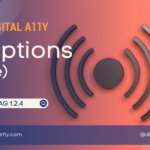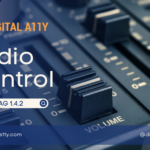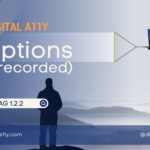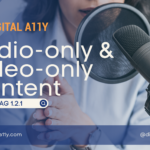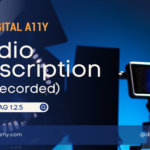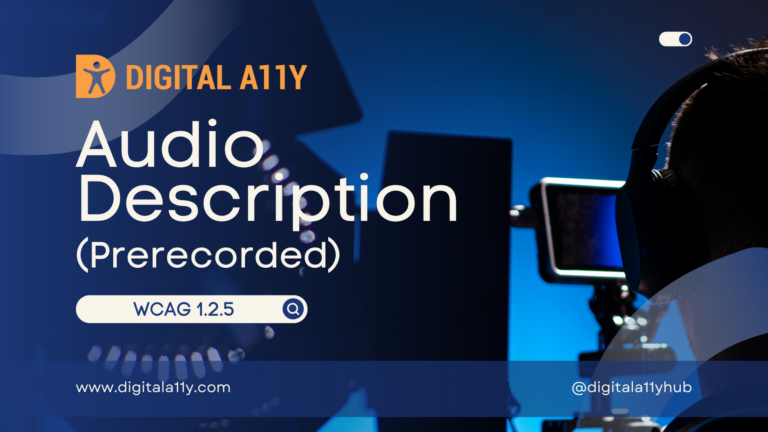Understanding WCAG SC 1.2.3 Audio Description or Media Alternative (Prerecorded)

1.2.3 Audio Description or Media Alternative (Prerecorded): An alternative for time-based media or audio description of the prerecorded video content is provided for synchronized media, except when the media is a media alternative for text and is clearly labeled as such. (Level A)
Audio Description or Media Alternative (Prerecorded) Transcript
Hello everyone. Today, we’re going to talk about audio description or media alternative. We’re also going to talk about its importance, requirements, and some examples. Now, let’s understand what audio description is. The audio description, also referred to as video description or visual description, is a form of narration used to provide information surrounding key visual elements in the media work, such as films, television programs, or theatrical performances, for the benefit of Blind and Visually Impaired consumers. These narrations are typically placed during natural pauses in the audio and sometimes during dialogue if deemed necessary.But why is audio description important? Video presentations convey information through a video visual medium. Users, like people without vision, people with limited vision, and people who are deaf and blind, may not perceive such information. An audio description is meant to provide information on visual content that is considered essential to the comprehension of the program, and text transcripts ensure that a person can progress through their information at their own pace.
Now let’s understand the requirements of an audio description and text transcripts. One should insert the description of the visual content at the pauses in the video. An extended or separate audio track description can be implemented as well. Audio description should include any visual actions, texts that are spoken as dialogues, and even a description of an animated logo, sceneries, facial reactions, etc. One should be careful with how much description is necessary for the users to understand the description and also to fit within the pauses in the videos.
The requirements for the text transcripts are: One should indicate the speakers based on the type of content. One should put the information in logical paragraphs, lists, and sections. It should have an interactive transcript that includes visual descriptions, dialogues, laughs, claps, text displayed, etc. Also, if any interaction, like answering a call, is included in the video, include links with the same functions.
Let’s see an example. Take a moment to imagine this description, almost as if you were reading it from a book: “A Snowman shuffles up to a purple flower, beeping out of deep snow. He takes a sniff. His nose lands in a frozen pond. A reindeer looks up and pants like a dog. Seeing the reindeer slip on the ice, the Snowman smiles and moves towards him, though actually, he’s running on the spot. The reindeer falls on his chin. The Snowman uses his arm as a crutch. The reindeer paddles his front legs.” Without any visual illustrations, this description paints a pretty vivid picture of a scene from the movie Frozen.
This is the end of the video. Thank you for joining. If you like the video, do like and subscribe.
This success criterion intends that video with audio that presents significant visual content has another alternative form. Video should be provided with either an audio description or an alternative transcript. The alternative transcript must explain all the visual content part of the video. Having either the audio descriptions or the transcript will pass this success criterion.
Understanding WCAG conveys:
- Providing audio description of the video content: The audio description supplement’s information conveyed through actions, characters, scene changes, and on-screen text available during the dialog pauses and which is conveyed only through visuals. Eg: The advertisements on the television that says, Order our product through the telephone numbers displayed on the screen. This information must be spoken out so that the viewers with blindness and visual challenges too benefit.
- Providing the information available in the synchronized media in text form: This alternate for the time-based media provides the entire description of the synchronized media content not just restricted to the content during pauses like the audio description. Usually, full descriptions are provided of all visual information, including visual context, actions and expressions of actors, and any other visual material. In addition, non-speech sounds (laughter, off-screen voices, etc.) are described, and transcripts of all dialogue are included. The sequence of description and dialogue transcripts are the same as the sequence in the synchronized media itself. The alternate for the time-based media also takes care of the interactions in the synchronized media.
